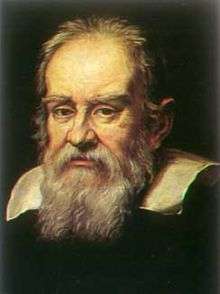Thermoscope
A thermoscope is a device that shows changes in temperature. A typical design is a tube in which a liquid rises and falls as the temperature changes. The modern thermometer gradually evolved from it with the addition of a scale in the early 17th century and standardisation through the 17th and 18th centuries.[1][2]
Function

It is thought, but not certain that Galileo Galilei discovered the specific principle on which the device is based, and built the first thermoscope in 1593. The inventor could be his physician friend Santorio Santorio or another person of the learned circle in Venice of which they were members.[3] Devices employing both heat and pressure were common during Galileo's time, used for fountains, nursing, or bleeding in medicine.[4] The device was built from a small vase filled with water, attached to a thin vertically rising pipe, with a large empty glass ball at the top. Changes in temperature of the upper ball would exert positive or vacuum pressure on the water below, causing it to rise or lower in the thin column.[4]
Large thermoscopes placed outdoors appeared to cause perpetual motion of contained water, and these were therefore sometimes called perpetuum mobile.[4]
Galileo's own work with the thermoscope led him to develop an essentially atomistic conception of heat, published in his book Il Saggiatore in 1623.[4]
Further history
The general pneumatic principle of the thermoscope was used in the Hellenic period, and it was written about even earlier, by Empedocles of Agrigentum in his 460 B.C. book On Nature.[4]
Santorio Santorio wrote a Commentary on the Medical Art of Galen in 1612 that described the device in print.[5] Shortly afterward, in 1617 Giuseppe Biancani published the first clear diagram. The device at this time could not be used for quantitative or standardized measurement, and used the temperature of air to expand or contract gas, thereby moving a column of water.[5]
The device was improved by early German scientist Otto von Guericke in the 17th century.[5] Ferdinando II de' Medici, Grand Duke of Tuscany personally made a further improvement by introducing the use of a colored alcohol, so that the material responding to heat was now liquid instead of gas.[5]
It is possible that Francesco Sagredo or Santorio may have added some kind of scales to thermoscopes, and Robert Fludd may have accomplished something similar in 1638.[6][7] In 1701 Ole Christensen Rømer effectively invented the thermometer by adding a temperature scale (see Rømer scale) to the thermoscope.[5]
See also
References
| Wikimedia Commons has media related to Thermoscopes. |
- ↑ Court, Arnold (12 May 1967). "Concerning an Important Invention" (PDF).
- ↑ Sherry, David (2011). "Thermoscopes, thermometers, and the foundations of measurement" (PDF). Studies in History and Philosophy of Science. 42: 509–524.
- ↑ Van Helden, Albert. "Galileo Project" (PDF). Rice University. Retrieved 18 June 2015.
- 1 2 3 4 5 Valleriani, Matteo (3 June 2010). Galileo Engineer. Springer Science and Business Media.
- 1 2 3 4 5 Burns, William (1 January 2001). The Scientific Revolution: an encyclopedia. ABC-CLIO.
- ↑ J. E. Drinkwater (1832)Life of Galileo Galilei page 41
- ↑ The Galileo Project: Santorio Santorio
- The Galileo Project, "The Thermometer"
- Benedict, Robert P., 1984. Chapter 1, "Early attempts to measure degrees of heat", in Fundamentals of Temperature, Pressure and Flow Measurement, 3rd ed, Wiley ISBN 0-471-89383-8.
